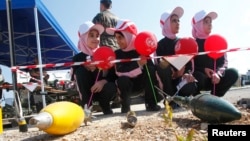Nabir Bzeih’s memory was wiped clean of the moment a decade-old cluster bomb exploded next to him, but he is only too conscious of the consequences.
One of six children wounded in the blast this spring from the bomblet in South Lebanon, it left him with a shattered leg and a new, bleaker reality.
“I used to play and go on walks and play football and go to the beach, but now I cannot anymore,” said the 13-year-old, whose brother was also injured, and who has not been to school since the incident. “My friends and I used to walk around together, but we can’t anymore. Everyone can come and go, but my brother and I can’t.”
Bzeih, who was walking from his village just six miles north of the border with Israel when the munition detonated, is a victim of the lethal legacy left by Israeli jets after the country’s war with Lebanon in 2006.
And now, despite best efforts, the number of those suffering a similar fate has started to rise once again.
Deadly legacy
Of the four million cluster bomblets left by Israeli forces in Lebanon during the war, an estimated quarter did not detonate on impact.
The result has been a clean-up operation that started in the aftermath of the conflict and continues to this day.
Complicating the matter is the remaining presence of mines planted during Lebanon’s civil war, which ended in 1990 after tearing apart the country for 15 years.
Khalil Saker, who works for the Lebanese Army-affiliated Lebanese Mine Action Centre (LMAC), is one of those tasked with clearing munitions, of which 300,000 are thought to remain.
“It is so high, the risk in our work, but we have to work because we must clear the area,” explained Saker, who, when excavating a cluster bomb holds one arm behind his back to save it should things go wrong, standard protocol in his line of work.
“It is our area, and we must clean it to save the lives of those who work in the fields,” he said.
More than half a million people still use land "contaminated" by cluster munitions, either living there or working there on a seasonal basis.
Because of necessity, half of those are continuing to use the land despite the risks, claimed Mine Action Group’s (MAG) country leader Bekim Shala.
For many, the impact of the cluster munitions is not just in the threat of explosion, but in the way its presence closes off access to the land they live off.
“They can no longer wait, and they have no other choice other than to start harvesting the land,” added Shala.
Alarming trend
Yet despite efforts to make southern Lebanon safe once again, the number of those killed or injured by munitions is now following an alarming trend.
In 2006, there were 209 accidents involving cluster bomblets and mines, a figure that had dropped to 9 by 2011.
However, with the exception of 2013, the number has since risen steadily, reaching 16 in 2014 and 19 already this year.
The onset of the Syrian war has played a crucial role in this trend.
Funding for MAG, which comes largely from international donors, is almost half its peak of around $10 million when clearance efforts began in 2006, while those who escaped the conflict for Lebanon are among the most vulnerable.
“For Syrians arriving here there are a lot of basic needs, meaning that a lot of donors have needed to mobilize support for them, which has a knock on affect for our funding,” Shala told VOA.
“There have been accidents involving Syrian refugees who are completely new to their surroundings and have no idea of cluster munition contaminated areas.”
Shifting priorities
With funding less readily available, though munitions clearance continues, efforts are now turning to focus on a more cost efficient alternative.
Nabir was not armed with the knowledge to recognize the small, muddy object that washed down onto a well-trodden path and changed his life.
“We feared the bombs, and did not go off the path as we knew they were nearby,” he said. “But I hadn’t seen pictures of them and didn’t know their shape.”
MAG’s Shala explained ongoing lessons warning locals of the dangers of mines are becoming an even higher priority. “As an activity it is a lot more cost effective [than munitions clearance] as it does not require the same number of people,” he said.
Meanwhile, there is a race against time to clear the munitions that has implications not just for Lebanon, but the wider world, he added.
As a key signatory to the Convention on Cluster Munitions, a global treaty aiming to fight the use of cluster bombs, Lebanon has pledged to clear cluster bombs by 2020.
“If the funding drops we’re not going to be able to achieve the obligation,” warned Shala. “That’s very sad because what message are we sending to other countries?









